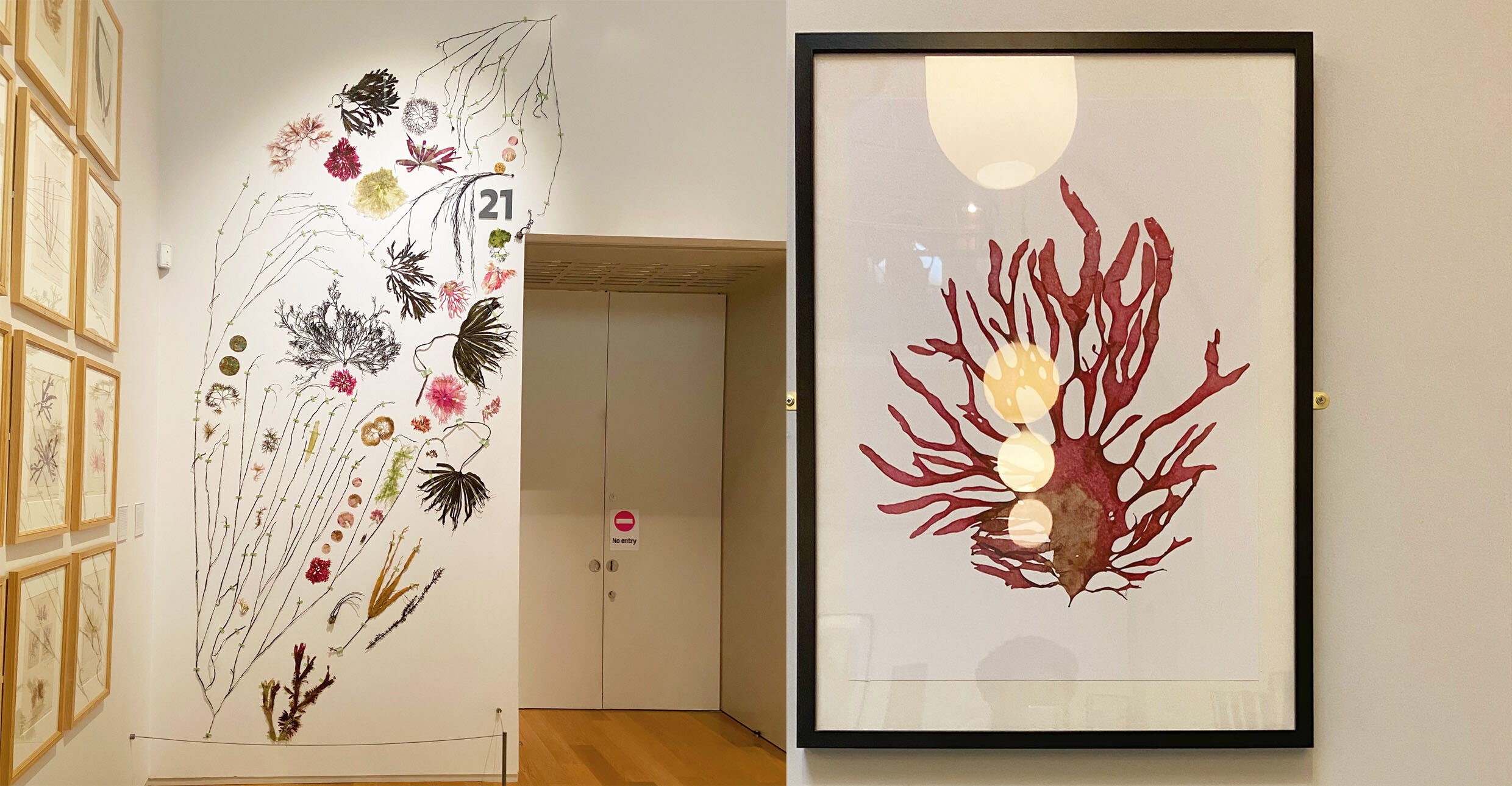Journal: Seaweed Exhibition Exeter
Lucy Skaer - seaweed art
“These prints are from “The Nature Printed British Seaweeds” by Henry Bradbury 1859. The seaweeds were meticulously gathered and plates were made direct from the specimens. It was an extraordinary logistical effort, considering the transport available at the time and the equipment needed. Lead plates were used to make a physical impression, a dent, of the seaweeds. The plates were then used as a mould to make a more permanent printing plate. Finally the colours were all applied by hand to each plate. I am interested in drawing out the irrational, sensual and emotional side of Bradbury’s project by adding my own idiosyncratic marks to his prints”. Lucy Skaer.
Crab Finger. Dorothy Cross.
Earlier this month I jumped on the train to catch the Sea grade at the RAMM in Exeter on its final day. It was the first exhibition of its type to focus purely on this subject matter in the UK. It was a fantastic show with varied artwork on display by talented artists, both local and international.
Most of the artists in the exhibition are female, a lovely nod to the fact that seaweed pressing was a favourable pastime undertaken by women. Many natural history and science sectors were off bounds to women, but botany was acceptable for a lady to pursue. Queen Victoria was a massive fan apparently.
I would highly advice going to see the exhibition but unfortunately unless you have a time machine this will not be possible. Maybe the show will pop up in another town. Here are some photos I took of the show and some background information about the work…
Old Victorian seaweed pressings part of the museums collection…
Close up, the colours and markings are beautiful for a piece pressed in 1852.
Amelia Warren Griffiths (1768- 1858) enjoyed seaweed pressing and helped bring it to the masses and make this a fashionable hobby with the Victorians.
Amelia lived in Devon and Cornwall, perfect places for seaweed hunting. Her and her friend, Mary Wyatt, made numerous volume of work that categorised the specimens found. She was well respected by her peers, many who were important experts of the era, like Swedish botanist Carl Agardh.
The Museum holds many pressings done by Mary and Amelia, including this one below…
Mary Wyatt’s books….
““Anyone who has walked on a beach or swum in the sea has usually seen seaweed as a dark mass, tangled, of indeterminate shape, usually part of the background rather than as compelling individual objects. The selection of seaweed pressing and prints in this exhibition shows much more; a seemingly endless variety of shape, size, form, texture and colour.” Jo Crook”
Jo Crook’s “Wrack Zone” and her beautiful seaweed pressings in the cafe…
““My work here is concerned with the shared cultures and traditions of the western Atlantic seaboard. This has been approached personally and in collaboration with Mollie Goldstrom, through a focus on the seaweed industries of the Hebrides, Cornwall and the Isles of Scilly and Brittany. Influenced by 19th Century life sciences in general and the great Victorian ‘seaweed mania’ the work borrows from the aesthetics of early photography, making lantern slides of the dried specimens to resolve very highly detailed silver-gelatin prints.” William Arnold”
Mollie Goldstrom and William Arnold
“The kelp burning industry provides the focus of Mollie Goldstrom’s work, which incorporates William Arnold’s cyanotype specimen records This work is a cross-continental merging of two distinct approaches and perspectives. William Arnold, a Cornwall native, is interested in the layers of human and natural history comprising the making of landscape and the role played by the metaphoric and literal photographic surface in recording, interrogating and representing these histories. Mollie Goldstrom, a New Englander, explores the inherently human desire to catalogue and order all surrounding life forms and systems while irrevocably altering and often destroying them through narrative drawing and writing, in a commingling of the encyclopedic and anecdotal. Working primarily with drawing, research and writing, Mollie Goldstrom explores seaweed as an object of curiosity, optimism, and transcendence as well as a reflection of human and environmental exploitation and devastation. Interlocking narratives and histories encompassing many centuries and coastal environments converge around macroalgae in its many uses and morphologies. Amidst anxiety about forces beyond individual control or comprehension; a rising climate of societal and ecological collapse, drawing becomes a personal means of creating order, wonder, and understanding”. (William Arnold).
Into the sea forest by Sarah Gordon
Sarah Gordon’s huge striking fabric curtain adorned with an oceanic menagerie of weeds and urchins is just simply stunning. Would love to have this fabric in my home, and it was actually for sale in the museum shop.
“‘I was inspired by often unnoticed details and imperfections of the natural marine world, such as
tangled seaweed and markings or patterns from seasonal changes or decay. I separated tones and colour variations from those elements into flat contrasting areas and drew inspiration from the natural growth patterns of connecting stems and vines which have given this work movement. I have been influenced by the simplicity and boldness of abstract art with the quirkiness of antique botanical illustrations which I've enjoyed finding a way to combine in my designs.’ - Sarah Gordon
Claude Cahun
Goodbye, until next time…








